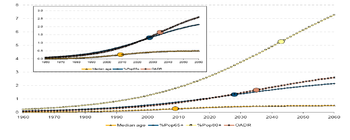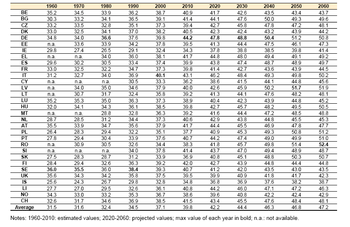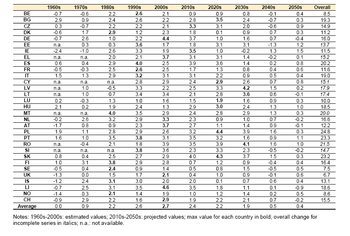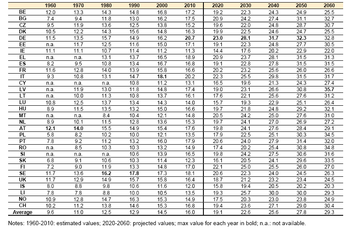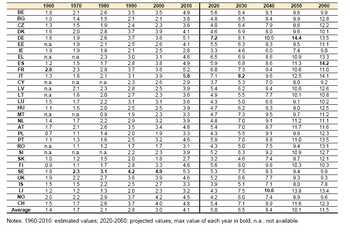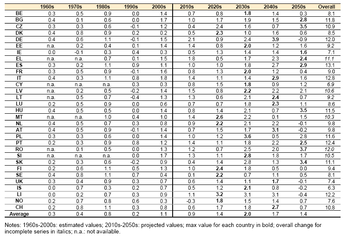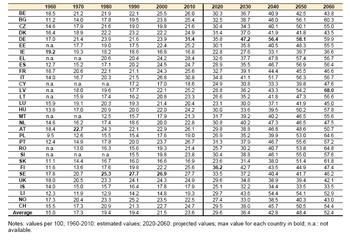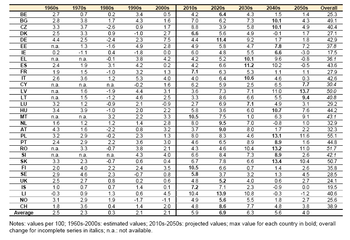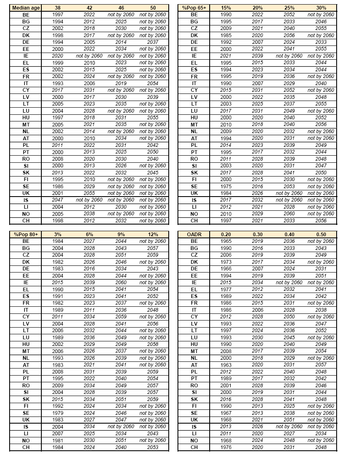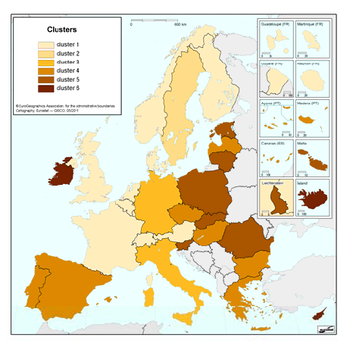This article is outdated and has been archived - for recent articles on Population see here.
- Data from April 2011, most recent data: Further Eurostat information, Main tables and Database.

This article looks at Eurostat’s latest population projection scenario (Europop2010) for the 27 Member States of the European Union (EU) and the EFTA countries. It focuses more particularly on population ageing, undoubtedly a key demographic challenge in many European countries over the next fifty years. Its implications for socioeconomic systems, such as public pensions programmes, health care or kinship structures, may be considerable.
Population projections are what-if scenarios that aim to provide information about the likely future size and structure of the population. The European Commission uses the results to analyse the impact of ageing populations on public spending.
Main statistical findings
Highlights
The greying of the baby boomers - A century-long view of ageing in European populations
In the second half of the 20th century, the progressive decline to low levels of fertility and lower mortality rates among the elderly resulted in population ageing in Europe. Positive or negative net migration flows tended to attenuate or intensify countries’ ageing processes. In particular, in the post-World War II period, fertility increased and subsequently declined in several countries: this demographic event, labelled as the ‘baby boom’, has been a further factor in the population ageing process of the 21st century.
Population ageing from 1960 (taken as the representative year of the baby boom) to 2060 (the year by which most of the baby boomers will have died out, is here measured by four commonly used indicators: the median age, the proportion of persons aged 65 and over, the proportion of persons aged 80 and over (the ‘oldest-old’) and the old-age dependency ratio. This analysis merges estimated values from 1960 to 2010 with projected values from 2011 to 2060, taken from the Eurostat Population Projections 2010-based (Europop2010): these latter figures should not be considered as forecasts, but just as one of the possible future demographic developments. 2010 is therefore taken as the pivotal year from which we can look half a century backwards or forwards. Figure 1 shows the range of values for the ageing indicators in 2010, which suggests that the ageing process is not at the same stage everywhere. Countries with relatively high values on one indicator tend to have high values for the others, but the ranking of the country may well vary.
The grey wave is sweeping south-eastwards
For a large part of the 20th century, Sweden was the country with the highest median age: starting at 36 years, it was finally overtaken only in the midnineties, when Italy took the lead, until the beginning of the new century (Table 1). The next oldest country, Germany, was also almost always in the top ranks (even in first position for a while) and it is expected to be so for the next thirty years. After 2040, Latvia and then Romania are projected to have the highest median ages, evidencing the eastward shift of the ageing process. In fact, by that time, Sweden is expected to have one of the youngest populations in Europe, together with most of the Nordic and Western Europe countries, while most of the Southern and Central-Eastern Europe countries may be above the average (see Figure 2). Similar geographical patterns can be detected in the percentage of the population aged 65 and over (Table 3), which increases by a factor of approximately 3 within just one century, and in the percentage of the population aged 80 and over, where the increase factor is of a spectacular order — of almost 9 on average. By 2060, most of the countries are likely to have a proportion of oldest-old of more than 10 %, as against the 1-2 % a hundred years before (Table 5). Likewise, the old-age dependency ratio may reach levels of more than one elderly person for every two persons of working age (Table 7), or even around two for every three.
Grandparent boom approaching
No matter what the indicator, no country is projected to have a lower value in 2060 than in 2010. In fact, these projected values are unprecedented in any human population: over the course of history, populations may have boomed or shrunk, but their age distributions have never been shaped almost like reversed pyramids, with the oldest age classes bigger than the youngest ones. Whereas in 1960 there were on average about three youngsters (aged 0-14 years) for every elderly person (aged 65 or over), by 2060 there may be more than two elderly people for each youngster: in other words, more grandparents for fewer grandchildren than in the past. What is more, the oldest-old may, on average, outnumber the children of less than five years of age by about the beginning of the next decade. Thus, the presence of great-grandparents may also become more common, and the family more ‘vertical’ (more generations) than ‘horizontal’ (more siblings): so maybe we are in for a ‘grandparent boom’.
Ageing to accelerate in the coming years… or not?
In the period under consideration (1960-2060), the trend of the median age across countries is more or less generally S-shaped: while in the first decades the indicator values are almost stationary, they increase over a period overlapping the beginning of the new century and then stabilise at a higher level. The varying factors are the time at which the increase begins, its extent and the speed of the increase. In particular, this latter element is relevant because a higher speed leaves less time to make socio-economic adaptations to the demographic changes. Assuming that the average median age for the countries with missing values in a given year is equal to the average of the other countries, we can show an S-shaped trend using the relative differences from a base year, as in Figure 3. For instance, in 2010 the relative increase is 0.26, meaning that since 1960 the average median age has increased by 26 %, from 31.5 to 39.8 (Table 1).
An S-shaped trend can be approximated accurately by a logistic curve, which also removes empirical irregularities: Figure 3 shows how the median age accelerates in the first part of the curve and then decelerates. By the end of the period, the median age is almost stationary on higher values, corresponding to an increase of about 50 % from the starting value in 1960.
A similar approach can be taken for the other three indicators. Assuming that their trends can be represented by a logistic curve, their relative increases from 1960 can be modelled as shown in Figure 4. The upper-left panel in Figure 4 is a zoom which makes it easier to visualise the modelled trends of the three indicators, as they have an order of magnitude smaller than the proportion of oldest-old. Besides their different magnitude, Figure 4 also shows the different timing of these ageing indicators. In fact, the logistic curves always have a point (the inflection point) which divides the period in which the curve is accelerating from the one in which it slows down. Of the four ageing indicators, the first to decelerate is thus the median age, where slowing down (on average) may have already started. On average, the proportion of the population aged 65 years and over may instead continue to grow at an increasing pace until about the end of the next decade, before decelerating. The old age dependency ratio may follow, with a delay of several years, and the proportion of oldest-old may not start its slowing down until a few decades from now. Such results are, however, conditional on what happens in terms of fertility, mortality and migration even beyond 2060.
Therefore, with all the caution proper to very longterm assumptions, the question of whether the ageing process is perceived as accelerating or not depends equally on which indicator is adopted. For instance, if we settle on median age, then the acceleration may be already over; if instead the oldest-old are considered, then growth may continue to be exponential for decades.
Hence, in the period 1960-2060, the ageing process accelerates at the beginning and then decelerates, and the inflection point (the moment when acceleration switches to deceleration) may be different not only across indicators, but also across countries. A simple way of looking at the speed of ageing is to consider its increases by decade. From Table 2 we can see that six countries, made up of the Nordic countries and Malta, already had their highest increase in the 1980s. In the next decade, seven countries, mostly in Central-Western Europe, recorded the highest changes in median age, followed by other countries in the same geographical area at the beginning of the new century. Projected values show that the highest speed of ageing (in terms of median age) may be still to come in most of the Eastern Europe countries. For the majority of countries, the proportion of persons aged 65 and over is projected to attain the highest increase within two decades (see Table 4). Greece, Spain, Italy and Portugal, though, may start slowing down only after the 2030s, followed by some Eastern Europe countries. The gathering pace of increase of the oldest-old would follow, with a delay of at least 15 years, albeit spread over a longer period (see Table 6), as this proportion is especially dependent on reductions in mortality at the highest ages. The top pace of increase of the OADR is also spread across several decades (see Table 8), with the geographical pattern as described above: the first countries to reach it are mostly in Northern Europe, followed by the Western and Southern countries; finally, Eastern Europe countries are projected to reach the higher speed of increase only towards mid-century.
Excluding the median age indicator, where most countries have probably already passed the period of highest increase, the countries that are projected to face the earliest demographic changes include Germany, Poland, Romania and Slovakia, the first of these about one to two decades earlier. On average across countries, the higher increase is projected to occur in the 2020s for the proportion of persons aged 65 years and over and for the OADR, and in the following decade for the oldest-old. Although the health conditions of the elderly may be expected to continue improving, the rapid increase in the oldest-old is likely to present a challenge to social security systems. In particular, support for the elderly which has so far been forthcoming from family care may well reach its limits in the coming decades as family patterns become more 'vertical'.
Different pacemaker countries over time
Since the magnitude of the ageing phenomenon is so important, the time it occurs may be of interest to policy-makers. Further, as the ageing process may bring important challenges to countries' socioeconomic structures, it may be useful to look at the experiences of countries that had already gone through such demographic changes.
For instance, Sweden was the first country to reach a median age of 38 years, in 1986, with the second one (Italy) following only seven years later (see Table 9, upper-left panel). However, it may take up to 43 years before the median age of Swedes increases by a further four years, and it may take much longer to reach higher thresholds — if ever. In the meantime, the level of 42 years for the median age was first reached by Germany in 2005. Germany may continue to lead the process, being the first country projected to cross a median age of 46 (in 2014) and of 50 (in 2037). This latter threshold is expected to be reached by 2060 by only a few other countries. Countries like Belgium, Denmark and Ireland, which are projected to have a median age lower than 46 by that time, may benefit from a differential of at least four years of median age from the pacemakers for a long period before 2060.
As the OADR is often used as an approximate indicator of the impact of ageing on public pensions systems, it is interesting to note that so far only a few countries have not yet reached an OADR value of 0.2, meaning 20 elderly persons for every 100 persons of working age (see the bottom-right panel of Table 9), the first one being Austria in 1963. However, it may take more than half a century before all these countries reach this level, the last one likely to be Slovakia in 2016. The situation may change more rapidly afterwards: only Italy in 2006 and Germany the following year have already crossed the OADR level of 0.3, but the rest of the countries are projected to do so within three decades. Several countries may up this ratio to 0.5 within the current half century, the first of them possibly being Germany in 2031. Greece, Spain, Italy and Portugal may follow within about ten years. An OADR of 0.5 means that there are two persons of working age for every elderly person, a ratio never before recorded. These pacemakers may thus be the first countries to tackle this demographic challenge.
Groups of countries ageing together
Although population ageing may differ from country to country (different timing, speed and/or extent), similarities can be explored across the 31 countries under consideration. Figure 5B shows the results of an analysis which uses the values of the four ageing indicators in three selected years, representing the beginning of the ageing process (1990, the first year available for all countries), its current state and the projected situation in 50 years. By using a standard method of cluster analysis, the countries can be progressively grouped, as shown by the converging lines in that figure, based on their similarity in the ageing indicators. The vertical axis of Figure 5B reports a measure indicating the proportion of variance accounted for by the clusters. At each level it is then possible to draw a horizontal line, which identifies a number of clusters explaining the corresponding level of variation. For instance, the horizontal red line identifies six clusters, accounting for more than three-quarters of the variation.
Proceeding from left to right on the horizontal axis of Figure 5B, the first cluster is composed of ten countries, located in Central and Northern Europe (see Figure 5A), that were on average relatively old in the 1990s but are projected to be among the youngest populations by 2060. The second cluster contains only Sweden, which was the pacemaker country at the beginning of the period and may turn out to be one of the youngest European populations a hundred years on. The third cluster includes two countries, Germany and Italy, which have a consistent record of aged populations. These two countries have been and/or will be the ageing pacemakers for a long period. The fourth cluster groups seven countries, spread across Europe, characterised by moderately aged populations, but with a prospect of relatively high OADR levels. The fifth cluster, of eight countries, mostly located in Eastern Europe, starts instead from much younger populations and finishes up with population structures probably almost as aged as the previous group. Finally, the last cluster is composed of three islands (Ireland, Cyprus and Iceland), whose populations were and may remain the youngest in Europe.
Closed European populations would age (much) more
If migratory flows were suddenly to stop from 2010 on, the overall outcome would be older European populations. At the end of the period under consideration, on average, the median age would be about three years more, the percentage of persons aged 65 years and over 3.4 percentage points higher, that of the oldest-old 2 percentage points higher, and the OADR would also increase by more than 8 points, from 52.4 to 61.0. The impact at national level depends on the level and direction migration is assumed to take over the next five decades. The countries for which the positive net migratory flows are projected to be more significant are those where the additional ageing due to no migration would be more relevant. For instance, Spain would reach a median age of 54.4 by 2060, instead of 49.7; on the other hand, in Romania the median age would increase by only 0.6 years.
Immigration can therefore be seen as an option for softening the ageing process. However, as immigrants are always older than newborns, if the population growth factor were to be immigration instead of fertility, then the ageing process would be softened less than in the case of a fertility increase. This effect is diminished if the fertility of immigrants is higher than in the host population.
Data sources and availability
Data sources and coverage
All data used in this publication have been calculated by the author from data stored in the demographic databases of Eurostat (see clickable data codes: (demo_pjan), (demo_pjangroup), (proj_10c2150p) and (proj_10c2150zmp)) and cover the EU Member States and the EFTA countries. Data for Germany always include the former GDR; data for France from 1960 to 1990 refer to Metropolitan France (FX); data for Cyprus refer to the government-controlled area.
Context
Population ageing is undoubtedly going to be a key demographic challenge in many European countries over the next fifty years. Its implications for socioeconomic systems, such as public pensions programmes, health care or kinship structures, may be considerable. The latest Eurostat projections (Europop2010) show that, over the next 50 years, population ageing is likely to attain unprecedented levels in 31 European countries, though the magnitude, speed and timing are likely to vary. In fact, population ageing has been a reality for decades now. In some countries it may already have passed its peak speed over a one-century period to enter a slowdown phase; in others, the process may speed up noticeably over the coming decades.
See also
Further Eurostat information
Publications
- The greying of baby boomers - Statistics in focus 23/2011
- Work session on demographic projections, Lisbon 28-30 April 2010 (jointly by Eurostat and UNECE)
- Ageing characterizes the demographic perspectives of the European societies - Statistics in focus 72/2008
- Work session on demographic projections, Bucharest 10-12 October 2007 (jointly by Eurostat and UNECE)
Main tables
- Population (t_populat), see:
- Population projections (t_proj)
- Population projections (tps00002)
- Projected old-age dependency ratio (tsdde511)
Database
- Population (populat), see:
- Demography (pop)
- Demography - National data (demo)
- Population (demo_pop)
- Population on 1 January by age and sex (demo_pjan)
- Population on 1 January by five years age groups and sex (demo_pjangroup)
- Population (demo_pop)
- Demography - National data (demo)
- Population projections (proj)
- EUROPOP2010 - Convergence scenario, national level (proj_10c)
Dedicated section
Methodology / Metadata
- Fertility (ESMS metadata file — demo_fer_esms)
- Mortality (ESMS metadata file — demo_mor_esms)
- Marriage and divorce (ESMS metadata file — demo_nup_esms)
- Population (ESMS metadata file — demo_pop_esms)
Other information
- Commission Green Paper (COM(2005) 94 final) "Confronting demographic change: a new solidarity between the generations”
- Commission Communication (COM(2006) 571 final) "The demographic future of Europe – from challenge to opportunity"
- The 2009 Ageing Report - Economic and budgetary projections for the EU Member States (2008-2060)
- Commission Communication (COM(2009) 180/4) dealing with the impact of an ageing population in the EU (2009 Ageing Report)



